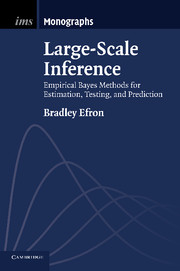Book contents
- Frontmatter
- Contents
- Prologue
- Acknowledgments
- 1 Empirical Bayes and the James—Stein Estimator
- 2 Large-Scale Hypothesis Testing
- 3 Significance Testing Algorithms
- 4 False Discovery Rate Control
- 5 Local False Discovery Rates
- 6 Theoretical, Permutation, and Empirical Null Distributions
- 7 Estimation Accuracy
- 8 Correlation Questions
- 9 Sets of Cases (Enrichment)
- 10 Combination, Relevance, and Comparability
- 11 Prediction and Effect Size Estimation
- Appendix A Exponential Families
- Appendix B Data Sets and Programs
- References
- Index
9 - Sets of Cases (Enrichment)
Published online by Cambridge University Press: 05 September 2013
- Frontmatter
- Contents
- Prologue
- Acknowledgments
- 1 Empirical Bayes and the James—Stein Estimator
- 2 Large-Scale Hypothesis Testing
- 3 Significance Testing Algorithms
- 4 False Discovery Rate Control
- 5 Local False Discovery Rates
- 6 Theoretical, Permutation, and Empirical Null Distributions
- 7 Estimation Accuracy
- 8 Correlation Questions
- 9 Sets of Cases (Enrichment)
- 10 Combination, Relevance, and Comparability
- 11 Prediction and Effect Size Estimation
- Appendix A Exponential Families
- Appendix B Data Sets and Programs
- References
- Index
Summary
Microarray experiments, through a combination of insufficient data per gene and the difficulties of large-scale simultaneous inference, often yield disappointing results. In search of greater detection power, enrichment analysis considers the combined outcomes of biologically determined sets of genes, for example the set of all the genes in a predefined genetic pathway. If all 20 z-values in a hypothetical pathway were positive, we might assign significance to the pathway's effect, whether or not any of the individual zi were deemed non-null. We will consider enrichment methods in this chapter, and some of the theory, which of course applies just as well to similar situations outside the microarray context.
Our main example concerns the p53 data, partially illustrated in Figure 9.1; p53 is a transcription factor, that is, a gene that controls the activity of other genes. Mutations in p53 have been implicated in cancer development. A National Cancer Institute microarray study compared 33 mutated cell lines with 17 in which p53 was unmutated. There were N = 10 100 gene expressions measured for each cell line, yielding a 10 100 × 50 matrix X of expression measurements. Z-values based on two-sample t-tests were computed for each gene, as in (2.1)–(2.5), comparing mutated with unmutated cell lines. Figure 9.1 displays the 10 100 zi values.
- Type
- Chapter
- Information
- Large-Scale InferenceEmpirical Bayes Methods for Estimation, Testing, and Prediction, pp. 163 - 184Publisher: Cambridge University PressPrint publication year: 2010
- 1
- Cited by

